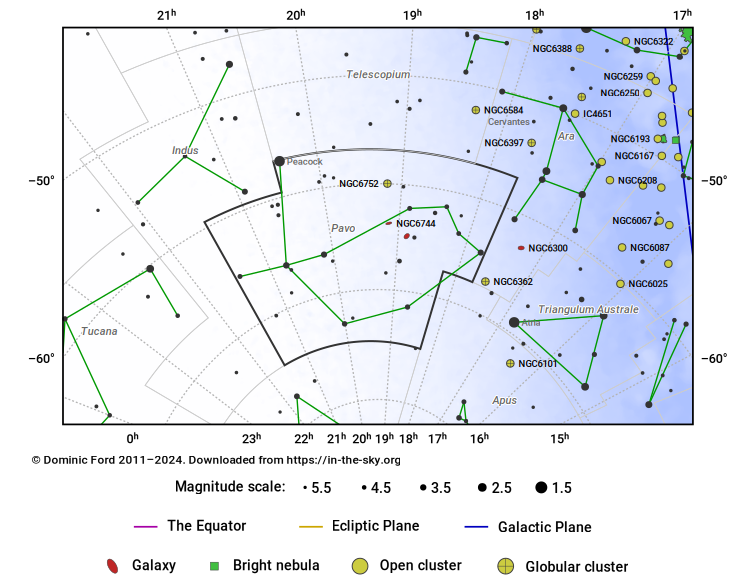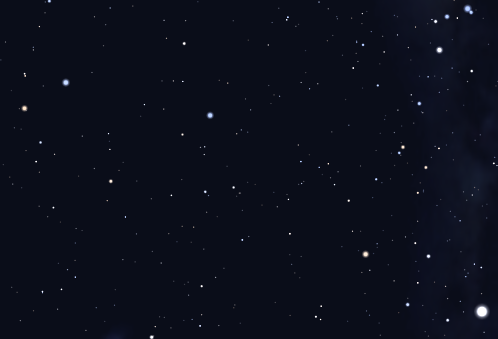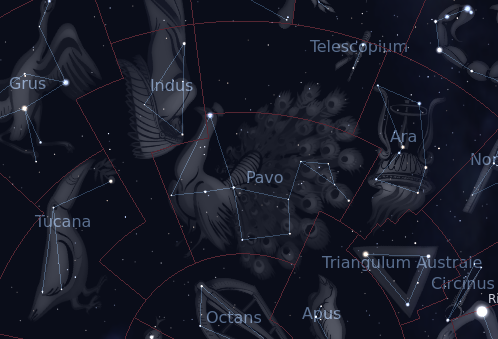The Constellation Pavo
Pavo lies close to the south celestial pole, where it is circumpolar across most of the southern hemisphere, but appears highest in the midnight sky in the months around July.
It was among a dozen constellations introduced by Pieter Dirkszoon Keyser and Frederick de Houtman which celebrate rare or exotic animals, and first appeared on star maps in 1598.
It is home to one second-magnitude star, called Peacock, but no other stars brighter than mag 3.4.
Lying away from the Milky Way, Pavo does not have many bright deep sky objects, with the exception of the globular cluster NGC 6752.
1598 (Keyser & de Houtman)
0.9% of the sky
377.7 square degrees
Pavo contains no Messier objects
Hover the pointer over the name of an object to highlight its position on the starchart to the right, or click to see more information.
| Stars | Open Clusters | Globular Clusters | Galaxies |
| Peacock (mag 1.9) | NGC 6752 (mag 5.4) | NGC 6744 (mag 9.0) | |
| β-Pav (mag 3.4) | NGC 6684 (mag 10.5) | ||
| δ-Pav (mag 3.5) | NGC 6876 (mag 10.8) | ||
| η-Pav (mag 3.6) | NGC 6753 (mag 11.0) | ||
| ε-Pav (mag 3.9) | IC 4662 (mag 11.1) | ||
| ζ-Pav (mag 4.0) | IC 4765 (mag 11.2) | ||
| λ-Pav (mag 4.2) | IC 5052 (mag 11.3) | ||
| γ-Pav (mag 4.2) | NGC 6943 (mag 11.4) | ||
| π-Pav (mag 4.3) | NGC 6810 (mag 11.4) | ||
| κ-Pav (mag 4.4) | NGC 6872 (mag 11.6) | ||
| ξ-Pav (mag 4.4) | IC 4901 (mag 11.7) | ||
| ν-Pav (mag 4.6) | NGC 6673 (mag 11.7) | ||
| φ¹-Pav (mag 4.8) | NGC 7020 (mag 11.7) | ||
| HIP 92024 (mag 4.8) | NGC 6769 (mag 11.8) | ||
| ρ-Pav (mag 4.9) | IC 4721 (mag 11.8) | ||
| O-Pav (mag 5.1) | NGC 6770 (mag 11.9) | ||
| NU Pav (mag 5.1) | NGC 6492 (mag 11.9) | ||
| υ-Pav (mag 5.1) | NGC 6483 (mag 12.0) | ||
| φ²-Pav (mag 5.1) | IC 4845 (mag 12.0) | ||
| ω-Pav (mag 5.1) | NGC 6782 (mag 12.0) | ||
| HIP 98174 (mag 5.2) | IC 4710 (mag 12.0) | ||
| HIP 94150 (mag 5.3) | IC 4704 (mag 12.0) | ||
| μ²-Pav (mag 5.3) | NGC 6721 (mag 12.0) | ||
| HIP 97534 (mag 5.4) | NGC 6730 (mag 12.1) | ||
| σ-Pav (mag 5.4) | NGC 6776 (mag 12.1) | ||
| HIP 97646 (mag 5.5) | NGC 7059 (mag 12.1) | ||
| ι-Pav (mag 5.5) | IC 4742 (mag 12.1) | ||
| HIP 94789 (mag 5.5) | IC 4831 (mag 12.1) | ||
| HIP 89487 (mag 5.6) | NGC 6739 (mag 12.1) | ||
| SX Pav (mag 5.6) | IC 4729 (mag 12.2) |




